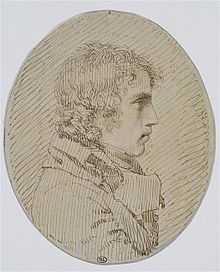Pierre Paul Prud'hon
Pierre Paul Prud'hon , occasionally Pierre Paul Prudhon (born April 4, 1758 in Cluny , † February 14, 1823 in Paris ) was a French painter at the transition from classicism to romanticism .
Live and act
Prud'hon became a pupil of the painter François Desvoges in Dijon . After his training there, Prud'hon settled in Paris as a freelance artist and specialized in portraits. At the suggestion of his teacher Desvoges, Prud'hon went to Italy for six years in 1782. There he studied the ancient artists and those of the 16th century, especially the works of Leonardo and Correggio . Most of the time he lived and worked in Rome , where he got to know the work of the sculptor Antonio Canova . In 1788 he returned to Paris and settled there again as an artist. During the French Revolution , Prud'hon led a rather poor life. He was not interested in politics, nor was he business-minded. During these years he married and had five children with his wife.
In 1799 he managed to take part in an exhibition in the Paris Salon and to draw attention to himself with a drawing. While the exhibition was still in progress, he was commissioned to design a room in the Louvre with a ceiling painting depicting Jupiter and Diana .
In 1800 the painter Constance Mayer came to his studio as a student. By that time, Prud'hon's wife had already been locked up for "scandalous behavior". After a short time his student became his lover. She looked after Prud'hon's children, financed him and made important contacts with the imperial court. When Prud'hon painted Empress Joséphine in 1805 , it was entirely thanks to his mistress. She also initiated Prud'hon's mediation as a drawing teacher for Marie-Louise of Austria . As a result, “tout Paris” wanted to be painted by Prud'hon. Mayer's works were often sold under the name Prud'hons in order to achieve a much higher price, which sometimes made it difficult to assign the works afterwards.
In 1816 the École des Beaux-Arts in Paris accepted the painter as a member. At that time, Prud'hon had already been given a spacious apartment with a spacious studio at the Sorbonne . Constance Mayer lived there with him, but in order to preserve her decency she had moved into her own apartment with a studio on the same floor. He had procured this as a teacher for his alleged student. On May 26, 1821 around 11 o'clock in the morning, Constance Mayer said goodbye to her student Sophie Duprat ; shortly afterwards she took her own life in her studio by cutting her throat. Speculations as to the reasons for her suicide ranged from a broken promise to marry to artistic self-doubt. The following year, Prud'hon presented a retrospective of Constance Mayer's works to the public in the exhibition of the Paris Salon of 1822 . He died in Paris on February 14, 1823 at the age of 65.
To the work
Prud'hon's importance lies in the fact that, unlike Jacques Louis David, he emphasized the painterly element and the effect of light. In Paris he had been close to David, but had not adopted his strict, graphic and plastic style. Rather, Prud'hon's painting was characterized by the impulses of the Roman Renaissance as well as that of the sculptor Canova and shows a special softness and sensitivity in style .
Prud'hon played a decisive role in the development of classical decorative painting in Paris, which he brought to monumental effect. His portraits consistently emphasize the self-confident demeanor of those portrayed, but also give them a certain melancholy. His chalk drawings, heightened with white on tinted paper, achieve an effect reminiscent of Correggio. As a master of soft tinting , he mediated between classicism and romanticism in France and initiated a rediscovery of the high renaissance. He also influenced the handicrafts of the Empire through furniture and decoration designs .
Works (selection)
- Jupiter and Diana
- Abduction of Psyches by Zephyr
- Justice and vengeance, persecuting the criminal
- The Zephyr swinging in the tree
literature
- Lexicon of Art . Vol. III, Verlag Das Europäische Buch, Berlin 1981, ISBN 3-88436-109-0 , p. 995.
- Rudolf Zeitler: The Unknown Century . In: ders. (Ed.): The art of the 19th century . Propylaea, Berlin 1979, ISBN 3-549-05051-8 , pp. 34, 142. (Propylaea art history vol. 11)
Web links
- Works by Pierre Paul Prud'hon at Zeno.org .
| personal data | |
|---|---|
| SURNAME | Prud'hon, Pierre Paul |
| ALTERNATIVE NAMES | Prudhon, Pierre Paul |
| BRIEF DESCRIPTION | French painter |
| DATE OF BIRTH | April 4, 1758 |
| PLACE OF BIRTH | Cluny |
| DATE OF DEATH | February 14, 1823 |
| Place of death | Paris |



